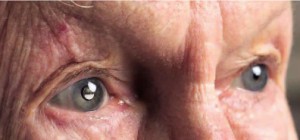By David A. Goldman, M.D.
CentraSight is the first treatment program to use a tiny telescope that is implanted inside the eye … Smaller than a pea, the telescope implant uses micro-optical technology to magnify objects that would normally be seen in one’s ‘straight ahead’ vision.”
 Imagine the heartbreak for someone who gradually loses the ability to see her grandchildren, husband and the people who mean the most to her. Now imagine her joy when she can see them again. Thanks to a groundbreaking new treatment program called CentraSight®, this dream can now be a reality for patients around the country with End-Stage age related macular degeneration (AMD), the leading cause of blindness in older Americans.
Imagine the heartbreak for someone who gradually loses the ability to see her grandchildren, husband and the people who mean the most to her. Now imagine her joy when she can see them again. Thanks to a groundbreaking new treatment program called CentraSight®, this dream can now be a reality for patients around the country with End-Stage age related macular degeneration (AMD), the leading cause of blindness in older Americans.
More than 15 million Americans are affected by some form of macular degeneration, a progressive disease that can lead to severe vision loss in its most advanced form, End-Stage AMD. The number is expected to double with the rapid aging of the U.S. population. Approximately 2 million Americans have advanced forms of AMD with associated vision loss.
Macular degeneration attacks the macula of the eye, where one’s sharpest central vision occurs. Although it does not cause complete blindness, patients with End-Stage AMD have a central blind spot, or missing area, in their vision. This vision loss makes it difficult or impossible to see faces, read, and perform everyday activities such as watching TV, preparing meals, and self-care.
For many people, the first sign of AMD is something they notice themselves. Straight lines like doorways or telephone wires may appear wavy or disconnected. When they look at someone, their face may be blurred while the rest is in focus. Lines of print may be blurred in the center or the lines may be crooked.
CentraSight is the first treatment program to use a tiny telescope that is implanted inside the eye to treat End-Stage AMD. Smaller than a pea, the telescope implant uses micro-optical technology to magnify objects that would normally be seen in one’s ‘straight ahead’ vision. This image is projected onto the healthy retina in the back of the eye not affected by the disease.
The telescope implant improves patients’ vision so they can see the things that are important to them, increase their independence, and manage everyday activities again. They can feel more confident in social settings because they can recognize faces and see the facial expressions of family and friends.
The CentraSight treatment program focuses on comprehensive patient care, requiring potential patients to undergo medical and vision evaluation to determine whether they may be a good candidate. A unique aspect of the evaluation is the ability to simulate, prior to surgery, what a person may expect to see once the telescope is implanted to determine if the improvement possible will meet the patient’s expectations. After an eye surgeon implants the telescope in an outpatient procedure, the patient then works with vision specialists to learn how to use their new vision in their everyday activities.
The telescope implant is not a cure. Patients must meet age and cornea health requirements to be considered a good candidate. Possible side effects include decreased vision or vision impairing corneal swelling.
The CentraSight treatment program is now available at Goldman Eye. For more information on the telescope implant and who qualifies for the treatment, visit www.CentraSight.com or call Dr. Goldman’s office at (561) 630-7120.
Check Also
Trusted Homecare Agency: Serving Veterans with Free Supplemental Home Healthcare
When it comes to healthcare, veterans deserve the best care possible. For veterans seeking in-home …
 South Florida Health and Wellness Magazine Health and Wellness Articles
South Florida Health and Wellness Magazine Health and Wellness Articles




